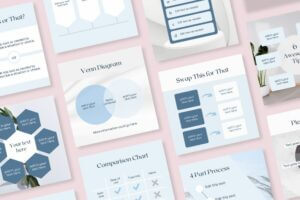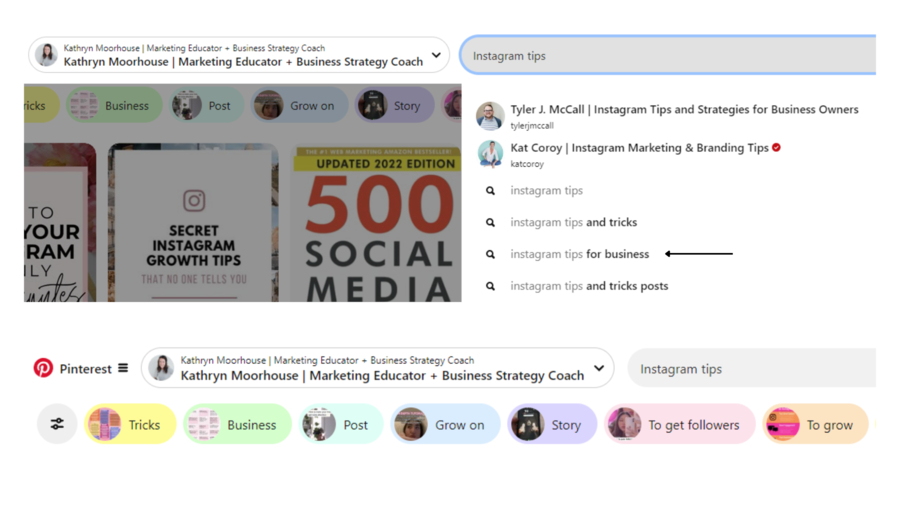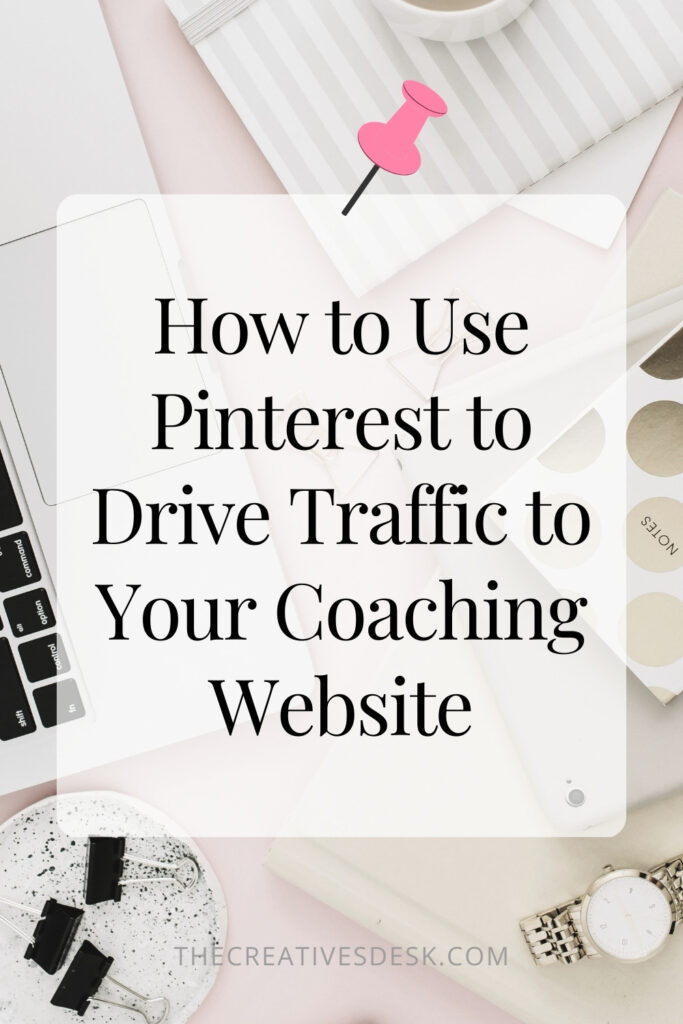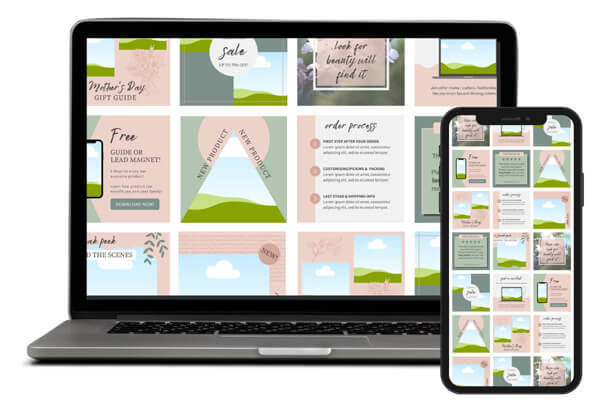

Guest post by Kathryn Moorhouse
As a coach, growing your business is all about finding the right strategies to drive traffic to your website and connect with your audience.
Pinterest is a powerful platform that can help you reach more people, drive them to your website, and ultimately convert them into clients.
However, Pinterest is more than just a visual inspiration platform; it’s a search engine that can be leveraged effectively for your business—especially if you use the right Pinterest strategy.
In this post, I’ll share five key ways to use Pinterest to drive traffic to your coaching website and set yourself up for success.
One common mistake is using your business title as your main keyword—like “life coach” or “business coach.” While these titles describe your services, most Pinterest users aren’t searching for a “coach”; they’re searching for a solution to their problem.
If your business focuses on helping clients with marketing strategies, for instance, then your potential clients may be searching for phrases like “how to grow on Instagram”, “marketing tips”, or “content creation tips.”
Do this instead:When doing your Pinterest keyword research, focus on the problems and needs your ideal clients are facing. Think about what challenges they’re looking to overcome and use those terms in the Pinterest search bar to find the right keywords to use.
Let’s say you’re an Instagram marketing coach.
The topics you cover include: Instagram marketing, Reels, Content Creation, Social Media, and more.
To find the right keywords start with one of those topics and type it into the Pinterest search bar to find relevant keywords your clients may be using.

To effectively drive traffic to your coaching website, pin almost everything you create.
The beauty of Pinterest is that it’s not just for promoting one type of content. Whether it’s blog posts, podcast episodes, digital product sales pages, YouTube videos (ideally hosted on your website), landing pages for your coaching packages, or guest posts, each piece of content can become a pin that leads back to your website.
The more pins you create, the more opportunities you have to drive traffic.
A lot of coaches feel as though they can only share blog posts on Pinterest but pinners are open to so many different kinds of content. As long as it directly relates to what they were searching for, and solves their problem, they’ll be happy you shared it.
How to do it: For each new piece of content you share on Pinterest, create multiple pins with different designs and headlines. This will increase the chances of your content being discovered by different types of users and give you more reach.
I often get asked, “how many new pin designs can I create for one piece of content?”. I usually tell them the number of new pin images you could create for one landing page is limitless.
Pinterest loves it when creators design new fresh pin images for their older content or landing pages they’ve shared on the Pinterest before.
Don’t be afraid to create a lot of great pin images for your older content or content you’ve already shared on Pinterest.
| Check out our range of Pinterest Canva Templates
Your boards should be strategically designed to not only showcase your content but also align with what your ideal clients are searching for.
Think of your boards as a way to organize and categorize your content based on different pain points, solutions, and interests that your audience is looking for.
How to Do It: Look at the topics you create content around and build boards around each of these themes.
If you help clients with marketing and mindset, create boards with names like “Content Marketing Tips,” “Instagram Growth Strategies,” or “Mindset for Entrepreneurs.”
Each board should include keyword-rich descriptions to help them get found by the right audience.
Pro Tip: Don’t just create board names based on what you think they should be, do proper keyword research and use the best keyword for that board as its board name. Be strategic!
Free resources like downloads, webinars, or newsletter sign-ups are great for driving traffic and growing your audience.
Create pins that lead directly to these resources and include a clear call-to-action in your pin description. The goal is to encourage users to click through to your website and take action—whether that’s signing up for your newsletter, downloading your freebie, or registering for your free training.
How to do it: Design eye-catching pins that clearly communicate the value of your free resource. A well-designed pin with compelling copy will entice users to click through to your landing page.
Once the pinner is on your email list, nurture them and guide them through your product offering. Provide value along the way to help them solve their unique pain points.
In my 10+ years of experience working with Pinterest clients and Pinterest manager students, I’ve discovered that the sales funnel focused on leading a Pinterest user onto your email list (and having a proper email sequence for conversion in place) is one of the most profitable things you can do.
Pinterest users are buyers and they can/do buy immediately.
But they’re also the email list members that have generally converted the most during launches and through email sequences, even years later. This is based on my own experience with my clients and students, so this isn’t a scientific study 🙂 just an observation.
When you notice a pin is getting a lot of clicks or saves, it’s a sign that users are interested in that content.
Make sure the landing page the pin is leading to is optimized for conversions. This means including your freebie, an invitation to join your email list, or a direct call-to-action to work with you. The more aligned the landing page is with the pin content, the more likely you are to convert that traffic into leads or clients.
How to do it: Regularly check your Pinterest analytics to identify your top-performing pins.
Update the corresponding website landing pages to ensure they provide value and have a clear next step for users who click through and work with you.
Pro Tip: Make the most of your top pins by offering a valuable free resource on the landing page and providing an easy way for potential clients to learn more about your coaching services. If you don’t want to have an email list or engage in email marketing, provide a clear and simple way the client can take the next step with you.
Pinterest can be a wonderful platform for driving traffic to your coaching website when used strategically. By implementing these tips and being intentional about your keywords, boards, and content, you can reach your ideal audience and grow your business.
If you’re looking to refine your Pinterest strategy or need help with keywords, don’t miss out on my Simplifying Pinterest Keywords course or the Pinterest Strategy Playbook—resources designed to help you confidently drive more traffic to your site!

Share to…

Sign up to get 10 free Canva templates for your social media.
Created with solopreneurs in mind, these templates offer a variety of content types to help boost your online presence!